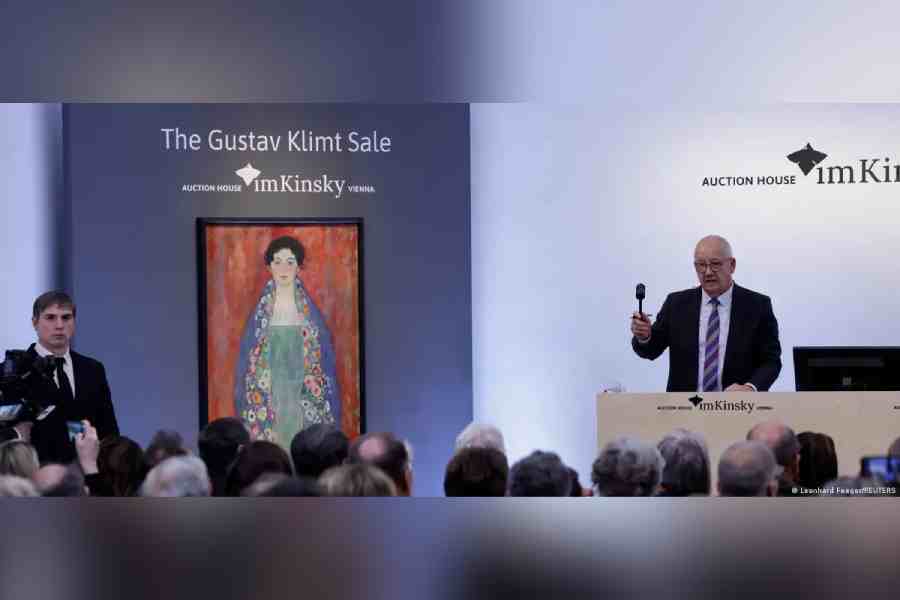The young woman's gaze is direct yet benign. A cloak richly decorated with flowers is wrapped around her shoulders, contrasting starkly with the painting's red background.
For almost 100 years, "Portrait of Miss Lieser" was thought to have been lost. Then the work by Austrian Art Nouveau painter Gustav Klimt (1862-1918) suddenly appeared at an auction.
"Miss Lieser" was painted during Klimt's last creative period, shortly before the artist's death. The artist's signature is missing, which is why it is believed that he didn't have time to finish the work before dying of a stroke.
The Viennese auction house Im Kinsky sold the work at the end of April for €30 million ($32 million) — a sale that wasn't as sensational as expected. There was a single bidder for the work, and the auction house's estimated price, set between €30-50 million, was barely reached.
The auctioneers were presumably disappointed, as Klimt paintings are otherwise known to fetch record prices.
For example, the Viennese artist's "Lady with a Fan" was sold to a private collector from Hong Kong at Sotheby's in London in 2023 for over $108 million. In 2006, the US billionaire and art collector Ronald Lauder paid around $135 million for "Portrait of Adele Bloch-Bauer"— Klimt's famous "woman in gold."
Why the provenance of the work matters
Many observers saw the sudden appearance of the "Portrait of Miss Lieser" as a bit of an art thriller. It definitely led to many questions: Who is the person portrayed? Who commissioned the painting and was its original owner? What happened to the painting during the Nazi era? How did it end up on the art market after being part of an — unnamed — Austrian private collection?
When the painting reappeared, most of those questions were unanswered. But many aspects needed to be cleared to allow the auction to even happen.
Most crucially, was the Klimt painting once owned by Jews and were the owners forced to sell it under the Nazis' pressure? If so, it would have to be treated as a restitution case today and returned to the owners' heirs in accordance with the Washington Conference Principles on Nazi-Confiscated Art of 1998.
If that were the case, it would have been legally difficult to export the work from Austria, and selling it abroad would have been almost impossible.
The Vienna auction, it seemed, was not off to a good start. Provenance research and negotiating skills were required before a sale could take place.
Jewish family Lieser
The auction house's research revealed that the commissioner and first owner of the painting was presumably Henriette Amalie Lieser, known as "Lilly," a patron of the Viennese art scene and the wife of the industrialist Justus Lieser until 1905.
Lilly Lieser died in a Nazi extermination camp in 1943. The person portrayed could be one of her two daughters.
But another branch of this Jewish family could have also owned the painting — namely Adolf Lieser and his wife Silvia. Their daughter Margarethe was 18 years old when Klimt painted the portrait.
It is conceivable that Lilly Lieser sold the painting when her assets were "Aryanized," i.e. frozen, after Austria's annexation to Hitler's Germany.
Auction house Im Kinsky said they did not find any evidence of confiscation or of "illegal expropriation." They nevertheless assumed the worst case, and treated the work as potential Nazi-looted art, and thus as a restitution case.
Undisclosed agreement reached
The auction house said that an agreement had been reached between the current owner and the legal successors of the Lieser family, which will lead to the auction proceeds being divided between them.
"It was these many ambiguities and historical gaps that prompted the current owners to contact the legal successors of the Lieser family and to agree on a 'fair and just solution' with them all in 2023," Im Kinsky said, without identifying the current owners.
"It has been agreed not to disclose the contents of the said agreement; however, it can be stated that all conceivable claims of all parties involved will be settled and fulfilled through the auctioning of the artwork," it said.
"The agreement essentially means that — from a purely legal point of view — it is immaterial who commissioned the painting from Gustav Klimt and which of the three young ladies in question it portrays."
Based on this agreement, the Austrian Federal Monuments Office issued an export permit, clearing the way for the auction, and making "Miss Lieser" attractive to international bidders too.
Another claim appeared before the auction
But shortly before the auction, a man from Munich also made an unexpected claim as the heir of the rightful owners. He demanded that the export license be withdrawn and that the auction be abandoned. If the man is entitled to inherit, the agreement on the proceeds would also be void.
The auction house did not react to the claim and went ahead with the auction, leading to the sale, for €30 million, of an unsigned portrait of young woman whose identity remains unclear.











